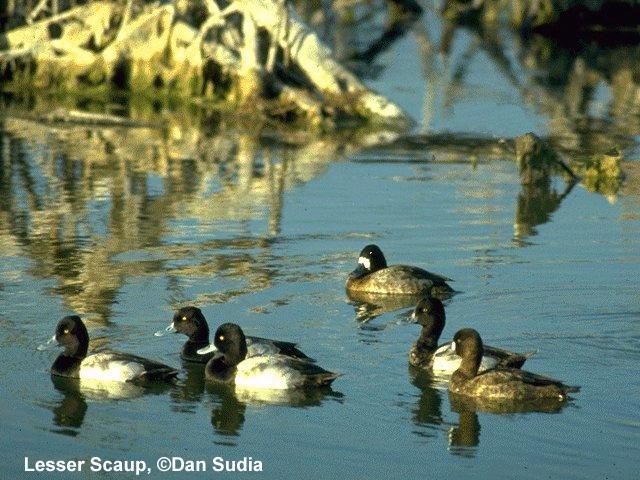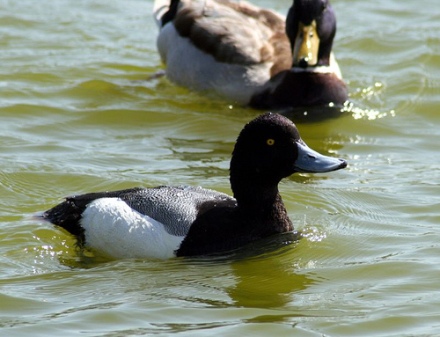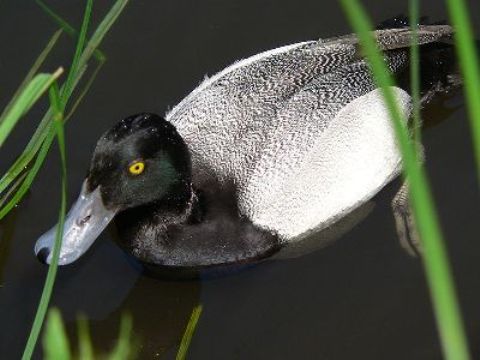
picture by J R Compton. http://www.JRCompton.com/photos/The_Birds/J/
Interactions
 When
it comes to interactions with other organisms, Lesser Scaup tend
to be quite social, laid-back ducks. Aside from early in their
breeding season, when males are focused on protecting their
partners, both sexes of Lesser Scaup are very tolerant of other
birds of their species, called conspecifics, as well. In fact,
at times they even work together with other Lesser Scaup such as
during winter when they construct flocks as large as 500,000
during molting and migration. During the hours of daylight, the
typical behavior of Aythya affinis can be described as quite
active and tending to forage for about 20 minute increments at a
time.
When
it comes to interactions with other organisms, Lesser Scaup tend
to be quite social, laid-back ducks. Aside from early in their
breeding season, when males are focused on protecting their
partners, both sexes of Lesser Scaup are very tolerant of other
birds of their species, called conspecifics, as well. In fact,
at times they even work together with other Lesser Scaup such as
during winter when they construct flocks as large as 500,000
during molting and migration. During the hours of daylight, the
typical behavior of Aythya affinis can be described as quite
active and tending to forage for about 20 minute increments at a
time.
Much like any other species, one of the conflicts that Lesser
Scaup do face is predation from other animals inflicted on them.
Most predation is geared towards Scaup ducklings as they are more
defenseless and therefore a better target than the adults, although
predation of adults does occur as well. In attempt to shield their
young from possible predators, female Scaup tend to keep the
ducklings near the cover of vegetation. Potential predators to baby
Scaup include black-billed magpies, great horned owls, American
coots, Arctic loons, Swainsons hawks, and black-crowned night
herons. Another form of predation on this species is for the
predator to capture and feed on the actual eggs belonging to the
females before they are even hatched. Some species that engage in
this kind of activity include common ravens, California gulls,
American badgers, raccoons, red foxes, crows, American mink, and
ring-billed gulls. Many of these aforeme ntioned species tend to prey
on young ducklings as well. Adult Aythya affinis, on the other hand,
do have a few of the same predators to worry about but also must
beware of
coyotes and skunks(primarily when located on their nests),
along with
peregrine falcons, snowy owls,
red-tailed hawks,
snapping
turtles, and bald eagles.
ntioned species tend to prey
on young ducklings as well. Adult Aythya affinis, on the other hand,
do have a few of the same predators to worry about but also must
beware of
coyotes and skunks(primarily when located on their nests),
along with
peregrine falcons, snowy owls,
red-tailed hawks,
snapping
turtles, and bald eagles.
Another form of interaction Lesser Scaup experience is parasitism
with numerous species. In specific, a common parasite that many
Lesser Scaup encounter, which is likely to lead to their demise, is
trematodes. These are worm-like small intestinal parasites which
require two intermediate hosts to complete their lifecycles, one of
which must be snails. The means by which Lesser Scaup become
infected with this parasite is by ingestion of these infected
gastropods, seeing as how they are an important and large part of
the ducks' diet, which then allows the trematode to infect and
thrive in the intestine of the bird. Aythya affinis that fall
prisoner to this parasite start becoming lethargic and struggle to
continue flying and diving. It is common for the infected ducks to
die around 3 to 8 days after ingestion of the infected snail usually
due to blood loss and shock. Faucet snails, or Bithynia tentaculata,
are a European species that have spread into the waters of Wisconsin
including the Mississippi River and are a common host of these
 trematodes. Specific species of trematodes that are known to induce
the aforementioned effects on Lesser Scaup include Cyathocotyle
bushiensis and Sphaeridiotrema globulus, which is less than 1
millimeter long.
trematodes. Specific species of trematodes that are known to induce
the aforementioned effects on Lesser Scaup include Cyathocotyle
bushiensis and Sphaeridiotrema globulus, which is less than 1
millimeter long.
A second parasite that Aythya affinis, among other species, has been known to harbor is Eimeria aythyae. The oocysts of this single celled parasitic protozoan of vertebrates has been found to take up residence in the intestines of the ducks which in turn leads to destruction and sloughing off of the mucosa as well as hemorrhaging, or loss of blood.
Humans also have interactions with Aythya affinis in that they are a species that is legal to hunt for food at certain times of the year. As for sick Lesser Scaup, which may be infected with a parasite, humans are advised to avoid ingesting these birds. The parasites which occur most often in Lesser Scaup have not been found to affect humans, yet it is still highly suggested that the birds be cooked thoroughly before consumption.
Read some interesting Aythya affinis facts at
Interesting Facts
Back to HOME